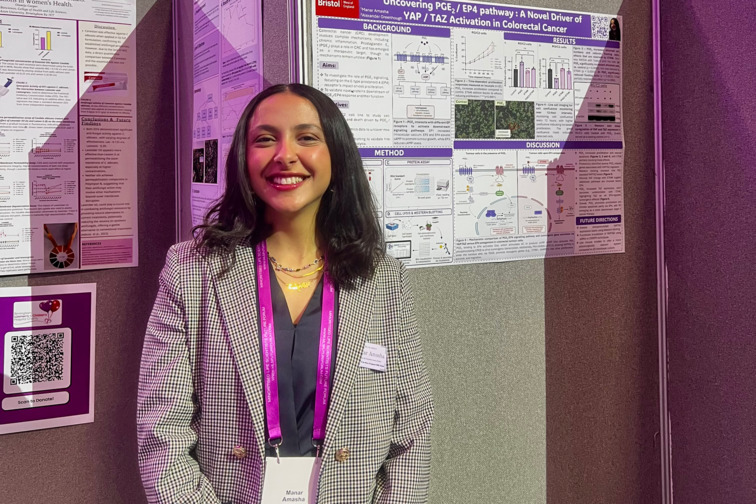Inflammation connection could offer new targets to manage colorectal cancer

New research shared at the Minoritised Life Scientists Future Forum has uncovered a prostaglandin E2 (PGE2) connection that could offer new targets to help with managing inflammation-driven colorectal cancer (CRC).
Manar Amasha, from the University of the West of England (UWE) Bristol, won a poster prize for sharing her research which explores how PGE2 - a molecule commonly elevated in chronic inflammation – drives the development of CRC, one of the most prevalent and deadly cancers worldwide.
Her research, supervised by Wallscourt Associate Professor Alexander Greenhough and his team, revealed that selectively blocking prostaglandin receptors, the key mediators of PGE2 signalling, significantly reduced tumour cell growth by reversed cancer-promoting processes such as increased cell proliferation and reduced apoptosis (programmed cell death).
“These findings support existing evidence, but what made the findings particularly exciting was the discovery that this pathway also influenced YAP and TAZ, two key proteins in the Hippo signalling pathway strongly implicated in cancer progression,” she explained.
“By uncovering this YAP/TAZ connection, our work highlights a promising and more targeted approach for managing inflammation-driven CRC”.
Prevalent and lethal
CRC is one of the most prevalent and lethal malignancies worldwide and a major global health concern, accounting for nearly 10% of all cancer diagnoses, with 1.93 million new cases and 935,000 deaths reported in 2020 (Sung et al., 2021). This cancer develops through a multistep adenoma-carcinoma sequence as first described by Fearon and Vogelstein in 1990.
Currently, the most effective treatment modalities for CRC include surgery, radiation, chemotherapy, targeted agents, and emerging immunotherapies, which yield the best outcomes when the disease is detected early (Xie et al., 2020). However, survival remains poor in advanced CRC due to limited treatment efficacy, and despite improvements in screening, incidence and mortality rates remain high, especially in high-income countries (Arnold et al., 2016).
“While non-steroidal anti-inflammatory drugs (NSAIDs) like aspirin have shown promise in reducing CRC risk through cyclooxygenase (COX) inhibition, their long-term use is constrained by serious adverse effects, including gastrointestinal bleeding and cardiovascular complications, highlighting the need for safer, more selective therapeutic alternatives,” Manar said.
“PGE2 – a lipid mediator elevated in chronic inflammation – plays a critical role in CRC progression. It promotes tumour growth by activating specific prostaglandin receptors in cancer cells. Although NSAIDs reduce PGE2 production and exhibit cancer-preventive properties, they also inhibit protective prostaglandins such as prostacyclin, leading to undesirable systemic effects.
Molecular mechanisms
“Our research set out to address this challenge by investigating whether selectively blocking specific PGE2 receptors, instead of all prostaglandin pathways, could safely suppress CRC progression. We aimed to better understand the specific molecular mechanisms behind PGE2’s tumour-promoting effects, with the goal of identifying more targeted and less harmful therapeutic strategies for patients at risk of inflammation-driven cancers.”
To model how PGE2 influences colorectal cancer cells, the team used a human cell line known to be responsive to PGE2 (Greenhough et al., 2010).
“We treated these cells with PGE2 and monitored their behaviour using live-cell imaging over 72 hours. PGE2 treatment significantly increased cell proliferation and reduced apoptosis, indicating that PGE2 drives tumour-promoting phenotypes,” Manar said.
“When we co-treated cells with selective prostaglandin receptor antagonists, both the increase in proliferation and the reduction in apoptosis were reversed. This confirmed that PGE2 promotes these cancerous behaviours primarily through prostaglandin receptor-mediated signalling.”
Proteomics data
To explore the underlying molecular drivers, an analysis of proteomics data was performed to identify proteins upregulated by PGE2. Bioinformatics analysis pointed to the Hippo-YAP/TAZ pathway as a major downstream effector of PGE2 signalling.
“We then validated these findings using western blotting, which showed that PGE2 increased the levels of both YAP and TAZ proteins. However, blocking prostaglandin receptors only reduced TAZ expression, with YAP levels remaining largely unchanged. This differential response suggests that TAZ could be more tightly regulated by prostaglandin receptor activity, but this will require further validation.”
“These findings not only show how inflammation promotes cancer on a cellular level but also point to new molecular targets for future therapies,” Manar said.
“Upon blocking prostaglandin receptors, TAZ expression was significantly reduced, while YAP levels remained largely unchanged, suggesting a more specific and previously underappreciated connection between inflammatory signalling and the transcriptional machinery that drives cancer progression – an insight that may pave the way for more precise, pathway-targeted therapies in colorectal cancer,” Manar said.
Inflammation fuelling cancer
The latest work adds to the understanding of how inflammation fuels cancer development and could inform new treatment strategies. By demonstrating that PGE2 promotes tumour growth through the prostaglandin receptors and activation of the YAP/TAZ pathway, this research highlights a molecular link between inflammation and cancer – something that could have significant clinical implications.
“Unlike traditional anti-inflammatory drugs such as NSAIDs, which non-selectively inhibit prostaglandin production and are associated with cardiovascular and gastrointestinal side effects, prostaglandin receptor antagonists offer a more targeted approach,” Manar said.
“Prostaglandin receptor antagonists may have clinical utility as they selectively block the tumour-promoting actions of PGE2 while sparing protective prostaglandins like PGI2. This could provide a safer and more effective strategy for long-term intervention. This selective inhibition could also disrupt tumour-specific signalling, such as the activation of TAZ, a key regulator of cancer cell proliferation and survival.
“In addition, during the course of my research write-up, I explored the broader implications of this specific prostaglandin receptor signalling on the immune system – particularly its impact on the tumour microenvironment (TME) and relevance to immunotherapy.
Potential of blockade
“Although not experimentally investigated in this project, literature evidence suggests that prostaglandin receptor blockade can reduce the infiltration of immunosuppressive cells in the TME, potentially enhancing anti-tumour immune responses and improving the effectiveness of immunotherapies.
“This highlights a promising and emerging connection between inflammatory signalling and immune modulation – specifically how PGE2 signalling might also affect immune cells in the TME – which warrants further investigation as part of future strategies combining prostaglandin receptor antagonism with immune-based treatments to achieve more durable and targeted cancer control.”
To build on these findings, the next step would be to validate the PGE2-TAZ signalling axis in more physiologically relevant models, such as 3D organoids and in vivo animal studies, Manar said.
“This would help us to determine whether blocking prostaglandin receptors not only disrupts tumour-promoting pathways in vitro but also translates into tumour regression or improved survival outcomes in vivo,” she said.
“A key focus should be on dissecting the specific role of TAZ in this process – particularly whether it acts independently of YAP in mediating PGE2-driven transcriptional changes. Clarifying this could inform the development of highly selective therapeutic strategies targeting TAZ-specific functions in CRC.
“Also, understanding the mechanisms of YAP/TAZ activation – whether they’re driven at the transcriptional or post-translational level – could guide the design of more effective drugs.”



